The Most Effective Guide to Email Marketing Campaigns
The Most Effective Guide to Email Marketing Campaigns

It has been 4 decades since the first prototype of an email was sent and to date, email marketing remains one of the most effective and profitable marketing channels. From audience-building to engaging with that audience and converting them into customers, email marketing has been the first choice of most marketers. On average, email generates $38 for every dollar spent, which is a 3,800% return on investment.
Here are the many ways you can (and should) use email
-
Build Relationships
Building and engaging with your audience via personalized user experience.
-
Brand
AwarenessMaking sure that your brand and your services remain at the top of your prospects’ minds.
-
Content
PromotionReaching the correct audience to promote your content or other useful assets.
-
Lead
GenerationEducating and empowering your audience to face their problems & quenching their thirst for knowledge in exchange of their email address.
-
Product
MarketingPromoting your products and services.
-
Lead
NurturingDelighting your customers with content that can help them succeed in their goals.
In this guide, we will walk you through the entire process of setting up your email marketing campaigns so that you can generate sales 24/7.
The Goal of the Email Campaign

Every email campaign needs to have a goal. For a lead nurturing email campaign, the goal will be to get the most open rates and increase the time spent on each email. For a promotional email campaign, the goal will be to get increased click rates and an uptick in the visits on your landing page. For emails with discount codes, the goal will be to get the subscriber to utilize the code while purchasing.
In order to set realistic goals for your email campaign, it is important to identify measurable metrics or KPIs. These can be done by referring to the market standards or industry-specific email marketing benchmarks. We’ll go through what we mean by Metrics and KPIs below:
Measurable Metrics
Metrics are the best indicators of subscriber actions on emails. When your subscriber opens your email, it contributes to the open rate. If someone clicks on the links in your email, it indicates that the email copy has piqued their curiosity enough to make them click the call-to-action button which in turn increases your click rate. If someone no longer wishes to subscribe to your email campaigns or marks it as a SPAM mail, all these actions will be logged as negative traits (i.e. Unsubscribe rate and SPAM rate respectively).
This table from the Email Marketing Benchmarks report by GetResponse highlights the email marketing metrics of different industries.
| Industry | Open rate | Click-through rate | Click-to- open rate | Unsubscribe rate | Spam rate |
|---|---|---|---|---|---|
| Agencies | 22.48% | 2.88% | 12.80% | 0.23% | 0.02% |
| Arts & Entertainment | 33.71% | 5.91% | 17.55% | 0.26% | 0.02% |
| Automotive | 17.69% | 2.44% | 13.80% | 0.30% | 0.01% |
| Communications | 26.74% | 5.34% | 19.96% | 0.14% | 0.01% |
| Education | 31.90% | 5.34% | 16.73% | 0.25% | 0.03% |
| Financial Services | 26.84% | 4.88% | 18.18% | 0.24% | 0.02% |
| Health & Beauty | 24.09% | 4.03% | 16.74% | 0.28% | 0.02% |
| Health Care | 32.49% | 5.35% | 16.46% | 0.34% | 0.04% |
| Internet Marketing | 15.82% | 2.58% | 16.28% | 0.21% | 0.01% |
| Legal Services | 30.66% | 3.46% | 11.28% | 0.24% | 0.03% |
| Non-profits | 37.54% | 4.65% | 12.39% | 0.22% | 0.02% |
| Publishing | 32.17% | 6.90% | 21.44% | 0.19% | 0.02% |
| Real Estate | 27.57% | 3.05% | 11.08% | 0.20% | 0.01% |
| Restaurants & Food | 41.37% | 5.62% | 13.59% | 0.28% | 0.02% |
| Retail | 22.86% | 3.72% | 16.29% | 0.22% | 0.02% |
| Sports & Activities | 32.01% | 4.33% | 13.52% | 0.28% | 0.02% |
| Technology & High Tech | 25.96% | 3.95% | 15.23% | 0.29% | 0.01% |
| Travel | 23.06% | 2.84% | 12.30% | 0.21% | 0.02% |
| All | 23.67% | 3.84% | 16.20% | 0.23% | 0.02% |
As you can observe, the open rates range from 37.54% (non-profits) to 15.82% (Internet Marketing), click rates from 6.90% (publishing) to 2.44%(Automotive). Since the unsubscribe rates and SPAM complaints are negative traits, these should ideally be as low as possible. The industry standard for unsubscribe rate is <0.30% and for SPAM is ~0.03%.
Key Performance Indicators
Key Performance Indicators are based on your email marketing practices and on different factors of your email campaigns. The most common Key Performance Indicators are:
- Delivery Rate
Email delivery is crucial to reaching the correct audience. The number of emails successfully delivered to your subscribers is known as delivery. The delivery rate is measured by dividing the number of emails delivered by the total number of emails sent.
- Conversion Funnel
The more refined your conversion funnel is, the more successful your email campaign shall be. Actions taken by prospects who progress their journey will help you to design the goals of specific email campaigns.
- Return on Investment (ROI)
This is the KPI in which email tends to perform best. ROI measures the returns compared to the expenses & investments you made on your campaigns. On average, an email campaign brings $38 revenue for every dollar invested. Here’s a handy tool from Sleeknote to calculate your return on email investment.
- Bounce Rates
Bounce rate is an indicator of your sender’s reputation and in turn of your email marketing practices. You can calculate it by dividing the total number of emails not delivered by the total number of emails sent. The bounce may be hard or soft.
Hard Bounce
When you send your emails to an invalid email address, wrong domain name, or your email gets rejected by spam filter, it is considered as a hard bounce. This is quite a serious issue to look into as it harms your sender reputation greatly.
Soft Bounce
When your emails are undelivered due to temporary problems such as attachment size, server downtime or overflowing mailbox, it is considered as soft bounce. This doesn’t impact your sender reputation much but should be avoided anyhow.
The cumulative result of an email campaign when compared with Key Performance Indicators answers how effective the email campaign was in achieving its goals.
Now in order to achieve these goals, you need to build an effective email strategy based on the end goal.
Building a strategy
Once you’ve got a goal, you need a strategy.
A strategy is a road map by which you will reach the goal you’ve set.

A good email marketing strategy helps you use the email channel to market your products and services in a manner which gives you the best chances for making a profit (while simultaneously building good relations with your subscribers). It must consider who your target customers are, their preferences and the benefits they are looking for, and which email marketing messages are the most effective.
The following is a step-by-step process to create your strategy:
-
step 1
Identifying your target audience
To send an email, you need a mailing list. Unless you collect the email addresses of those subscribers whose interests align with or are relevant to your brand, you are wasting precious time and stand a good chance of being tagged as a ‘Spammer’. So, the first step towards an effective email marketing strategy is identify your target audience. Study the average pattern of visitors on your website and create a demographic customer persona based upon this pattern. This customer persona helps in targeting similar people who might benefit from your services.
-
-
step 2A
What are their pain points?
In order to strike a conversation with your prospects, you need to first understand what brought them to your website. Study which pages they are visiting and how much time they are spending on average. If they downloaded any specific downloadable or freebie, you get some context from which you can start addressing their pain points in the lead nurture emails. Additionally, understanding their pain points can also help you understand which incentive works best for them to convert better.
-
step 2B
How your product/service helps them
Once you have identified the pain points experienced by your prospects, it is time to build the counterargument about how your product/service can help solve these issues. Plan how you will introduce your products since timing and presentation is of utmost importance. One wrong move and the message’s effectiveness might be lost.
-
-
step 3
How do you define each stage in the customer journey?
A prospect needs to travel through several different stages of a sales funnel. Ideally, they will convert at each stage and finally exit as the customer. The emails issued at each stage of a sales funnel offer different information to your email subscribers and, depending on the criteria you set for each stage, you promote (or demote) them. So it is very important to define each stage of the sales funnel and chart out a customer’s journey. The basic stages in a customer journey are:
Awareness
The prospect is aware about your brand and has a vague idea about what you’re offering.
Engagement
The prospect is engaging and interacting with different channels of your brand (website, email, social media post etc). Through this engagement they learn more about you, and become a lead.
Evaluation
The lead is evaluating how helpful your brand is to their problems.
Purchase
The lead makes a purchase and becomes a customer.
Product and Support Experience
At this stage the customer is looking for a good user experience and customer service.
Bonding
The customer is pleased with you and becomes a loyal customer who may suggest your brand to their circle.
-
step 4
Conducting Competition Analysis
An important step towards creating a marketing strategy is to learn how your competition is conducting their email marketing campaigns. By subscribing to their emails, you can analyze how they engage with their subscribers, what emails they send, how they retain and re-engage their dormant customers etc. Also, you may learn how they motivate the customer to take action and how they maintain a distinct ‘brand voice’ in their emails.
-
step 5
Past campaign analysis
Always learn from the past. By analyzing the past campaigns, you can:
- Take both a macro and micro level look at your email campaigns
- Identify problems with email design and delivery
- Improve key components of your emails to drive better response rates
- Decide if you're ready to upgrade to a new email service provider
- Create a plan for improvement
By analyzing past campaigns, you gain valuable knowledge about which emails worked in the past, what kind of subject lines worked best, how effective and actionable the call-to-action was etc. Here are the factors you need to analyze during an email marketing audit:
- List hygiene of your email list
- Segmentation criteria
- Trust built through your ‘From’ name and sender address
- Message conveyed from your subject lines and pre-header text
- Effectiveness of your email copy
- Placement of email elements and email design
- Sending time and frequency
- Effect on the email deliverability
-
step 6
Setting up a marketing calendar
All the time you’ve invested in your campaign strategy will gurgle down the drain if you don’t stick to a marketing calendar. A marketing calendar helps you to streamline all the processes, including devising the concept; writing the email copy; getting the template designed; getting it coded and tested for effectiveness; setting up the campaign; scheduling for multiple lists, and finally measuring the results. Also, a leak-proof marketing calendar helps you to plan your campaigns in advance while accommodating any last-minute changes.
Planning your email marketing calendar involves categorizing all your broadcast emails into general categories such as newsletter or blog update emails, time recurring (or date specific) emails, sales specific announcement emails and so on. Once the emails are categorized, start by populating the calendar with date-specific emails. Then, fill in your newsletter emails on the days they are scheduled to be sent. Finally, fill in the days when any promotional emails are to be sent. This way, you can observe any gaps between your email campaigns, which will help you to schedule better.
Still have questions on how to build an effective strategy?
Get expert insights
Getting your emails delivered
Tools you’ll need for your email campaigns
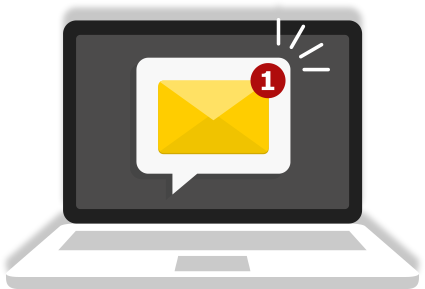
Email marketing nowadays is all about having one-to-one conversations with your subscribers. While you can send an email using any free email platform such as Gmail or Yahoo! Mail, this can bring problems regarding the disabling of some features in these platforms. Also, it doesn’t look professional, and sending bulk mails from free-to-use email services can flag your emails as SPAM.
Having one-to-one conversations with subscribers is especially difficult to manage when you have a huge subscriber base and all of your subscribers are at different stages of the sales funnel. So, email marketers make use of different tools while sending out email campaigns. Here are minimum email tools required for effortlessly setting your email campaigns:
Email Service Provider
For sending out any email, you need to have an Email Service Provider (ESP). An ESP is a Swiss army knife that offers you the provision of sending HTML email templates to a mailing list along with multiple features. Email service providers reserve a range of whitelisted Internet Portal (IP) addresses through which you can send your emails. A bare minimum ESP should have:
- Email template library
- List management
- Email template editor
- Analytics to measure campaign performance
- Basic merge tag capability
Mailchimp, Campaign Monitor, MoonMail and HubSpot are a few examples of ESPs.
Lead Capture Tools
As we stated earlier, in order to send an email to your subscribers you need to collect the email addresses of leads. For that, you need lead capture tools. Lead capture tools are basically forms which collect the email addresses of your leads. There are two types of Lead Capture tools:
- Those which ‘pop’ out and offer some incentive to the visitors in exchange for filling out a form, when they satisfy certain criteria.
- Static forms on landing pages that the subscriber can fill out when they land.
Hello Bar, OptinMonster, Leadin by Hubspot, SumoMe and Lead Pages are a few examples of Lead Capture tools.
Landing Page Builder
Daniel Burstein (Senior Director at MECLABs) states that “Email is the bridge between two landing pages”. So, before executing an email campaign, it is important to create a relevant landing page which mirrors the message conveyed in the email. Most ESPs provide in-built landing page builders. You can also find ad-hoc landing page building tools on the web, with which you can create stellar landing pages.
Unbounce, Instapage, Wishpond and Crazy Egg are a few examples of landing page builder tools.
Back-end CRM
This is the brain behind the entire email campaign (after you, obviously). CRM manages the interconnectivity between all your tools and processes all the data collected from each tool. For example, when a visitor fills out a form, CRM stores the email address and ‘informs’ the ESP to send a welcome email to the email address.
Salesforce Sales Cloud, Zoho and Infusionsoft are a few examples of CRM tools.
Building your email list
So, we’ve gone through the pre-requisites that you need to complete before you take up the responsibility of handling email campaigns. At this point, we assume that you have:
- A concrete goal decided for your email campaign
- Created a strategy to achieve that goal
- Created a rough email marketing calendar
- All the required tools setup and interacting with each other
Now, we move to the next stage of executing your email campaigns…
Building Your Audience
It is now time to build your audience. You’ll do this based on the target
audience which you identified while creating your email marketing strategy.

Improve brand visibility
The primary way to build your audience is to be visible to your prospects. There are multiple ways to improve brand visibility:
-
Cold Emails
When emails were first introduced to the masses in the late 1990s, marketers saw it as an opportunity to transcend geographical restrictions and find customers everywhere. This began the trend of cold emails. Cold emailing is the junk-mailing of the digital world. It involves getting the email address of your prospects and mailing them with no prior engagement or solicitation. Since this is not a permission-based marketing method, the effectiveness of this is comparatively low and leads to an increase in SPAM complaints.
-
Search Engine & Keyword Optimization
When a prospect is looking for a solution to their problem, the first place they’ll look at is a search engine. When your brand is the first result on the webpage, the prospect makes a positive association with it. SEO makes this more likely by optimizing the keywords on your website thus helping you to stay at the top of the search results.
-
Social Media and Forums
Another area of the digital domain in which people connect with each other are social media platforms and forums. By running digital ads on social media or being active on social forums, you bring the brand to your prospects and increase your brand visibility.
Different Ways to Generate Leads
Capturing ‘clean’ (i.e. real) email addresses is a bit of a fine art these days. But don’t worry – it is far from impossible. While it’s certainly not a case of ‘build it and they will come’, there are ways and means of encouraging people to enter their data into your subscriber form. Here are a few things which may help:
-
Engaging Content
Content to which your visitor can connect will help set expectations and make your subscribers look forward to your emails. Create gated blogs, full access to which is granted when the readers provide an email address. You can also motivate people to subscribe to your emails in order to continue receiving such helpful content. This kind of engaging content will hook in the attention of your visitors and convert them into leads.
-
Alluring Lead Magnets
By offering certain assets or resources as downloadable content, you will have people making a beeline to you. This is especially effective when you provide practical knowledge about solving a problem and show a realistic way to achieve the solution. Your downloadable resources should demonstrate the value that you provide as a company and give your prospects a glimpse of what they can gain from your product or service.
- eBooks
- A printable checklist
- Whitepapers or case studies
- Free trials or samples
- A free quote or consultation
- Quizzes or a self-assessment
- A discount coupon
-
Contest Promotion
Everyone looks for their ‘moment(s) of glory’. The hope of winning a contest is a powerful motivator. It is likely to increase contest participation, thereby increasing the volume of collected email addresses. By promoting contests over social media, you can increase the number of participants. A great example of this is a campaign by online t-shirt retailer Qwertee. They ran a quirky and eye-catching contest which promised winners a free t-shirt every day for a month (‘do no laundry for a month!’) It was amusing, enticing, and proved very popular indeed. Their subscriber list shot through the roof.
-
Collaboration Exchange
By collaborating with another brand, you become visible to their followers and vice versa. Utilize this tactic to expand your brand visibility and get more subscribers. Collaboration can be in the form of guest posting, an interview video, a mention on their social media post or paid promotions.
-
Collaborative Partner Referral
Similar to collaboration exchange, collaborative partner referral occurs when another brand recommends your emails or even directly refers leads to you.
-
Good SEO
Most leads do a lot of internet research before signing up to anything these days, so it’s vital that your SEO is on-point. Get your SEO practices up to scratch and the leads will follow.
-
Event Marketing
Garnering subscribers in the flesh, at events you attend (or even throw) is a great way to get those vital details as well as to connect on a truly individual way with prospects.
-
Webinar Registration
Everyone loves to gather knowledge irrespective of the source. You can provide value to the subscriber by organizing a webinar based on a common pain point and asking people to register with their email addresses.
-
Offline Collection
For those in the brick and mortar shops, you can collect signups for your mailing list at the checkout. Another alternative is to organize meetups, seminars, hackathons, educational panels, and even your own conferences to have the attendees subscribe to your emails to generate leads.
As a best practice for lead generation, either have a double opt-in or ask for explicit consent from the subscriber so that you can send them promotional emails. This is the first step towards permission-based email marketing (which we’ll go into in a bit more detail later).
List Cleaning
A successful email campaign relies on having maximum subscribers opening the emails. Statistically, 70% of the subscribers in an email list are decaying every year so it is important to weed out the dormant, inactive and irrelevant entries from your email list in order to maintain the list hygiene.
Inactivity may be owing to many factors, such as change in preferences, change of email address, switch to competition or even just a flooded inbox. Maintaining email hygiene regularly will ensure you are only emailing the people who truly want your messages, which also helps you avoid your email being marked as spam.
Email list cleaning involves splitting your entire email list into two parts:
Warm List
List of subscribers who have engaged with your emails regularly over the past 4 months (the duration can be changed as per your business and industry).
Cold List
List of subscribers who haven’t engaged with your email even once in the past 4 months.
The subscribers in the warm list are relevant to your business and should be retained, while the cold list subscribers have become inactive owing to any of the reasons we stated above.
The second step involves analyzing the last interaction which the inactive subscribers had with your emails. For someone who used to regularly open your emails but has stopped since, it is best to send them a re-engagement email, asking them to click a link if they wish to continue receiving your emails.
For those who occasionally open your emails, you can send them an email with an option to change subscription preferences.
For those who haven’t engaged with your emails for a long time, check for hard bounces which denote an error in the email address. If the email address looks correct, send an email asking them if they’d like to unsubscribe. You can ask them to fill out a survey if you want to know the core reason for their inactivity.
Additionally, you can opt for third party tools to scrub your email list and weed out irrelevant email addresses.
The Customer Journey
Onboarding Your Email Subscribers with Welcome Emails
Now that you have collected enough email addresses to create a mailing list, it is time to introduce them to your business.
As we covered earlier, when someone subscribes or provides their email address, they may be interested in your brand, but they don’t necessarily know much about you. At this stage, they are ‘prospects’ – prospective customers. You will need to ‘onboard’ them with a welcome email, in which you should thank them for subscribing.
This is the best time to set expectations about what they stand to gain from your emails and how many times you will be sending an email. In the below email, the copy states the days when the subscriber can expect the emails and, additionally, promises to send them premier and exclusive information.
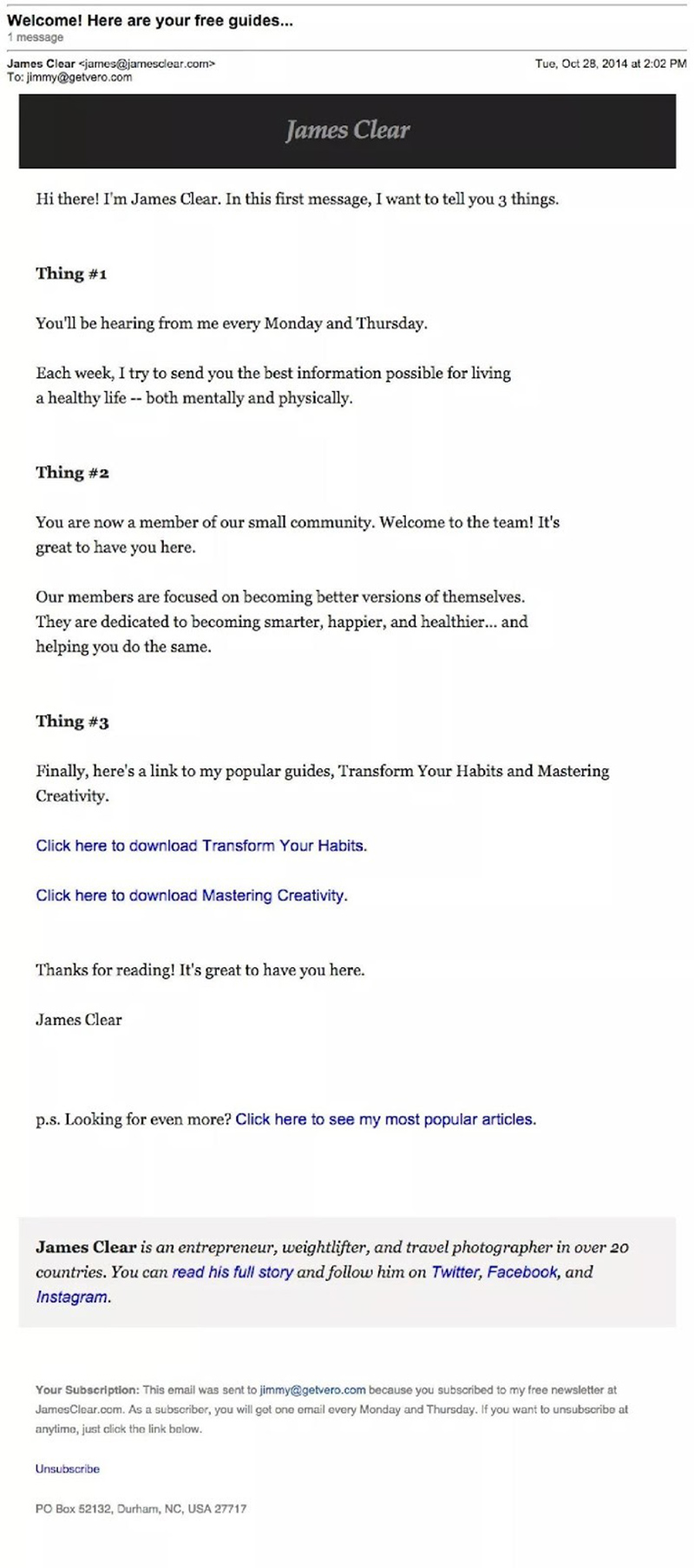
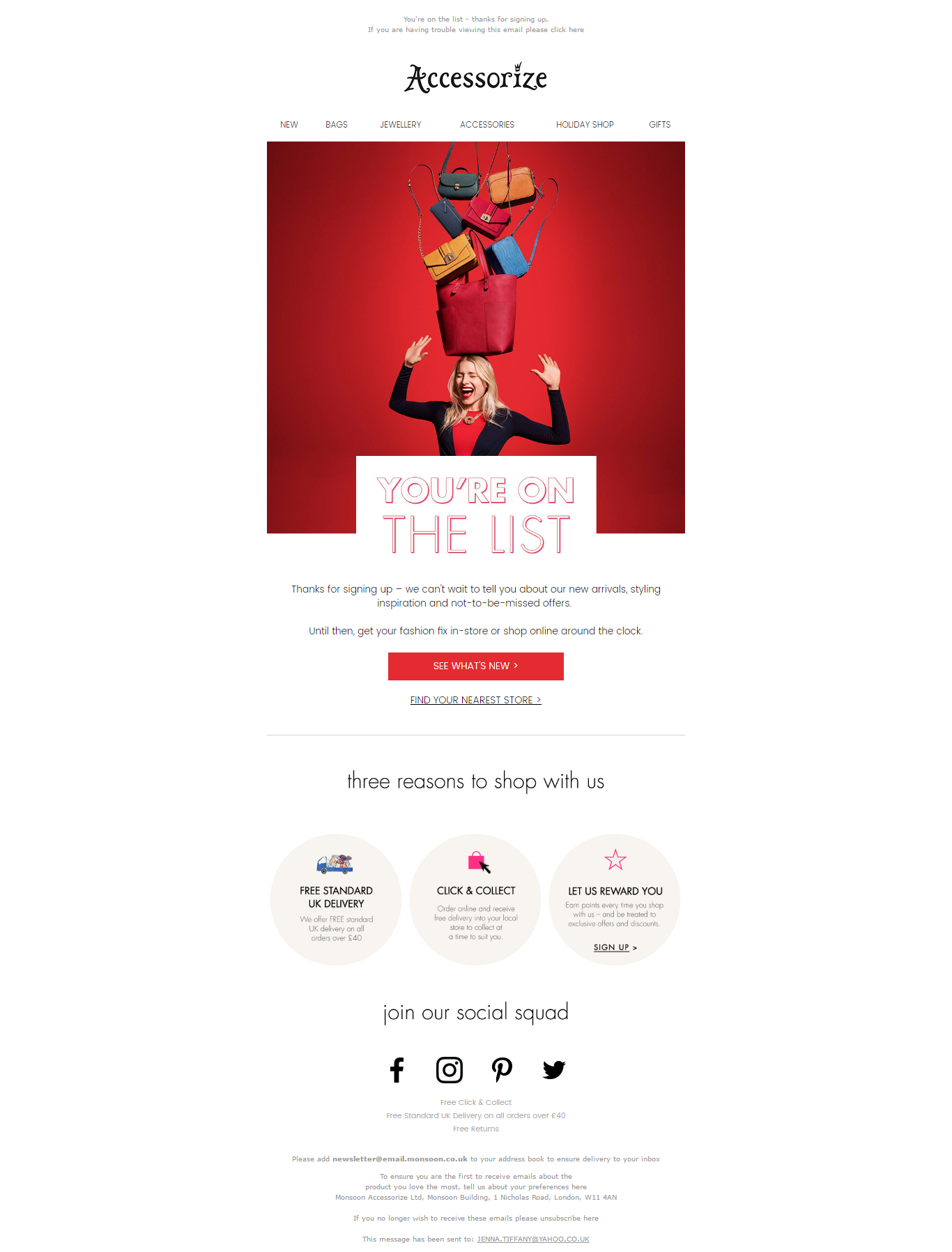
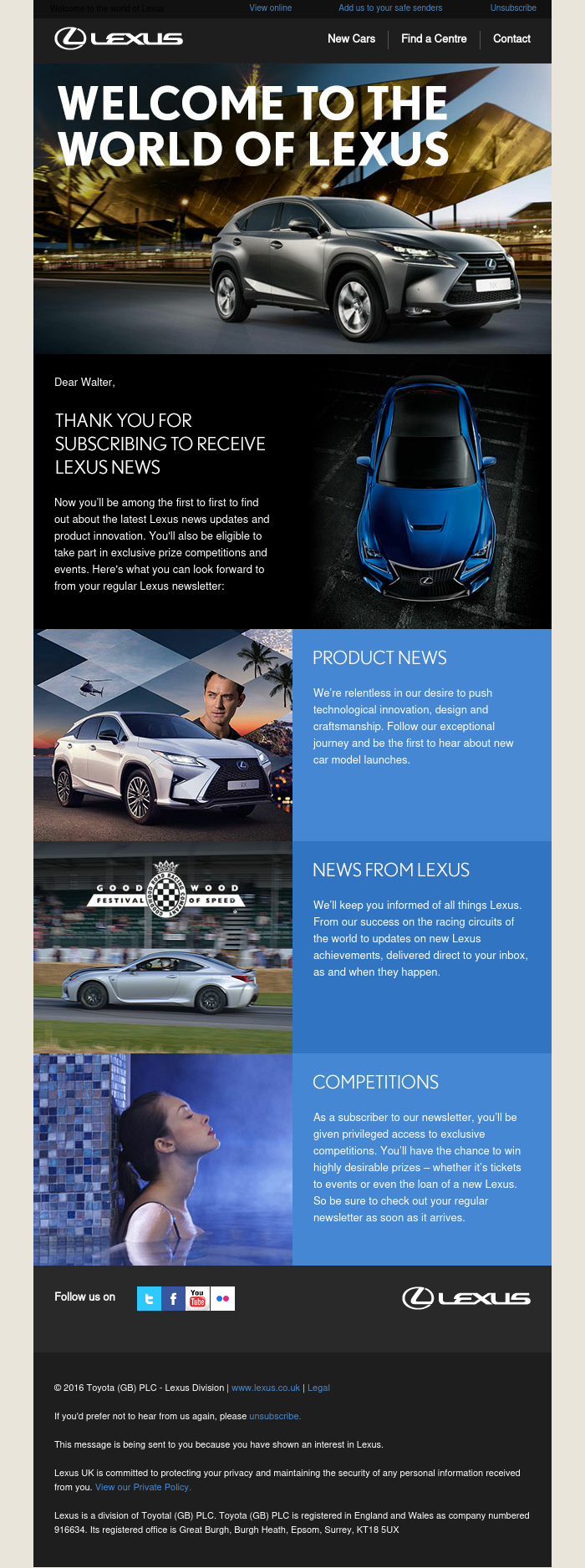
The welcome email is an extremely important part of your lead’s journey with you. If you get it right, you’ll create (and retain) engagement, gain a customer, and build the foundations for a productive ongoing relationship.
A welcome email needs to grab attention and interest from the get-go. Typical welcome emails may follow one or more of these patterns:
Welcome promotion. With this email, you’ll need to establish yourself as a point of interest. Give the customer what they want – be that a blog, a discount voucher, or an intriguing offer.
Subscriber thank you. Thank your new subscriber for signing up, and set their expectations regarding the type, frequency, and tone of the content you’ll be sending in the future.
Start-up. This kind of welcome email will tell the customer how to get started with your product/service/website etc.
Having initially welcomed your subscribers, you can follow up with a supplementary welcome. For example:
Product showcase. Introduce your new subscriber to the kinds of things you can offer them. Encourage them to browse your website and peruse your products.
Brand review. Let your new subscriber know about all the lovely things people have said about you. Send them content containing positive reviews (this will serve the dual purpose of increasing their faith in you and letting them know the kind of things you’re best at).
Social media engagement. Encourage your subscriber to engage more deeply with your brand by directing them to your social media pages.
Whitelisting Your Email Address & Other Permission-based Marketing Tips
When someone marks your email as SPAM, it registers a complaint with their Internet Service Provider(ISP). From then on, they will automatically blacklist emails coming from your sender address. Blacklisting prevents your email from reaching the inbox of your subscribers, which is obviously bad for your business.
Whitelisting is the opposite act of blacklisting. Being Whitelisted informs the ISP that your emails are safe, improving your sender reputation.
When you request that your subscribers whitelist your emails in your welcome email, you can expect more email visibility and therefore more engagement. In addition to the double opt-in (explained earlier), requesting to Whitelist is also a good step towards permission-based email marketing.
Some of the other tips for conducting effective permission-based email marketing are:
- Re-market to your inactive subscribers
- Respect their decision to unsubscribe
- Periodically offer your subscribers preference changes
- Ask them to share your emails with their peers
SPAM Laws of Different Countries (and Respecting Them)
For a global brand with a subscriber base from different countries, you need to respect the local and state laws while sending marketing emails. Non-compliance with the laws can incur heavy fines which will be counter-productive to your ROI (as well as wrecking your reputation). The most widely followed laws across the globe are:
- CAN-SPAM Act (2003) (USA)
- Anti-Spam Legislation (2014) (Canada)
- Unsolicited Electronic Messages Act 2007 (New Zealand)
- GDPR (European Union)
- Nigerian [Cybercrime Act 2015] (Nigeria)
The overall requirements in order to send marketing emails to the subscribers of most countries are common requirements (except GDPR):
- Opt-in required to send emails
- Clear identifications of From name and Sender address
- A physical address
- A visible and functioning unsubscribe link
- Request for unsubscribe be respected instantly
- No confusing email copy
Learning about your audience and segmenting them
Now that you are building your audience, it is time to get to know them better. Currently, the only information that you have about your subscribers are their names, email addresses and a vague idea of what drew them to your brand. By collecting further information, you will come to understand their interests, company names, customer lifetime value, location, age range etc. This collected information can be further segmented into different categories and analyzed to send your subscribers more personalized emails.
Let’s move ahead to how you can collect subscriber information for better segmentation and in turn provide a good user experience.
‘Complete your profile’ emails
Even if you only collect the name and the email address in your lead capture, you can motivate them to fill in further information moving forward. One of the best ways to collect information about your subscribers is simply to ask them outright and upfront for it. Sending them an email in which you ask them to complete their profile is a win-win for both the brand and the subscriber; the subscriber feels special that a brand is interested in knowing them better, while the brand gets all the details about their subscribers. In the below email by LearnVest, it is conveyed to the subscriber in a straight-forward manner that the next step after registering is that they complete their profile.
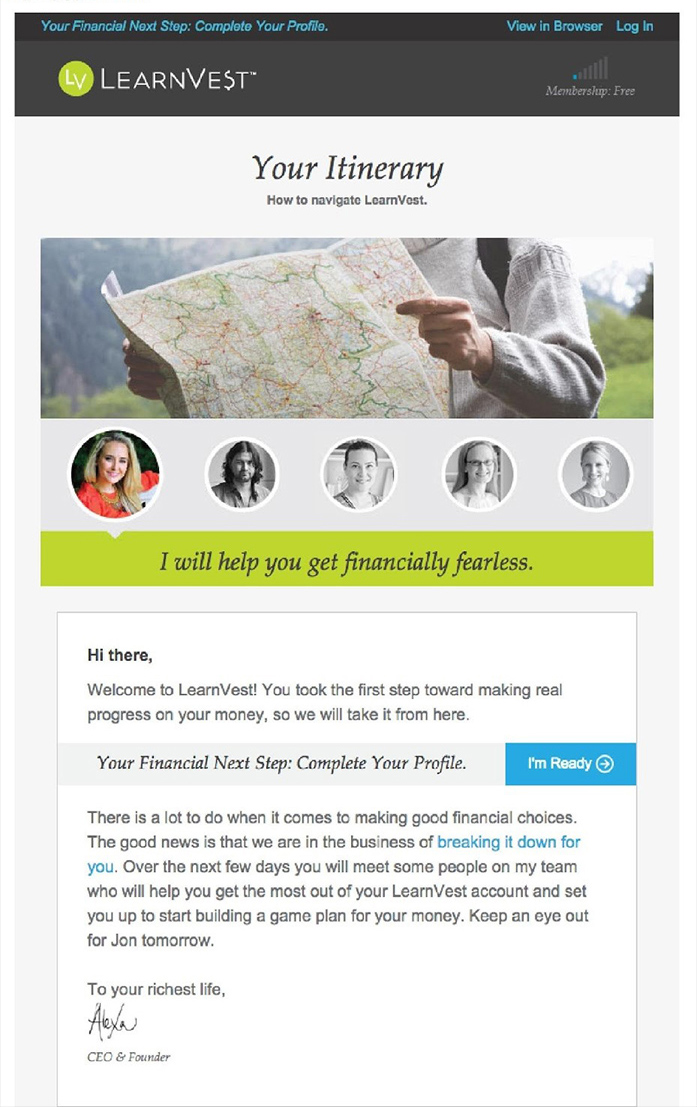
Creating Basic Demographic-based Segments
Once the subscriber fills out the profile, you have enough data to segment your email templates on a preliminary level. Information such as age, gender, company position, and income level, can provide general information about a person’s needs and interests. Based on your products and services, you can also fine-tune the segmentation data by asking about the company position (for B2B) or the places they are interested in visiting (for travel) or interests (for brands with multiple sub-brands) and so on.
Segmenting your subscribers based on the demographic data is the most basic way to segment your mailing list. Moving forward, you need to frequently update your segmentation criteria depending on other data which you’ll collect in later stages such as:
- Past purchases
- Buying frequency
- Activity level
- Product type (Durables or Replenishable)
- Devices used (Desktop or Mobile)
- Customer loyalty
- Visited pages
- Referrals, And many more
Creating Your Own Email Collection

The backbone of any email campaign is the set of emails you send. While B2B industry relies heavily on plain text emails for marketing, there are situations in which HTML emails are indispensable. Therefore, it is important to have several certain types of email templates in your arsenal, irrespective of whether you are part of the B2B or the B2C industry.
Basic Set of Email Templates That are Needed in Any Email Campaign
As part of your email campaign strategy, you will be sending different emails at each stage of the sales funnel. Keep in mind that the emails you send in an e-commerce email campaign will be different from those sent in a travel email campaign. Having said this, the most common set of emails that you need to send in any email campaign are:
The Welcome Email / Onboarding Series (Awareness Stage) - This does what it says on the tin. We’ve covered welcome emails above, but it won’t hurt to reiterate. The welcome series of emails should commence engagement with the customer and set their expectations for your relationship moving forward.
The Email newsletter Series (Awareness / Engagement Stage) - This series of emails builds awareness of your product/service and will encourage your subscriber to think of you when they’re looking for something within your remit. Be informative and encourage engagement as much as possible – but don’t be too pushy at this stage.
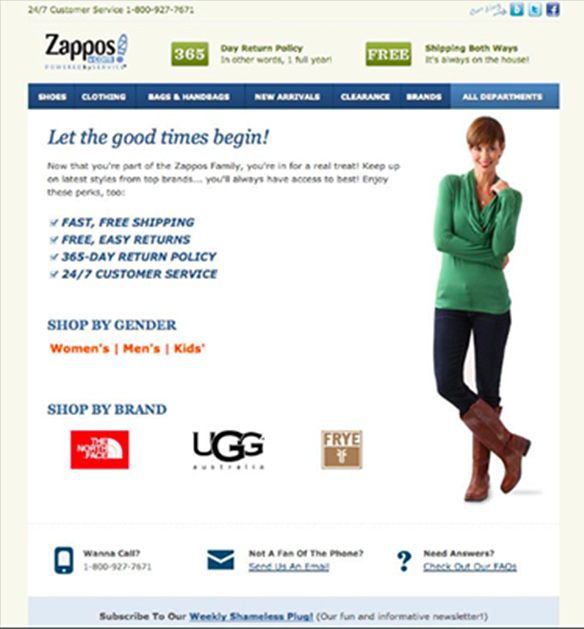
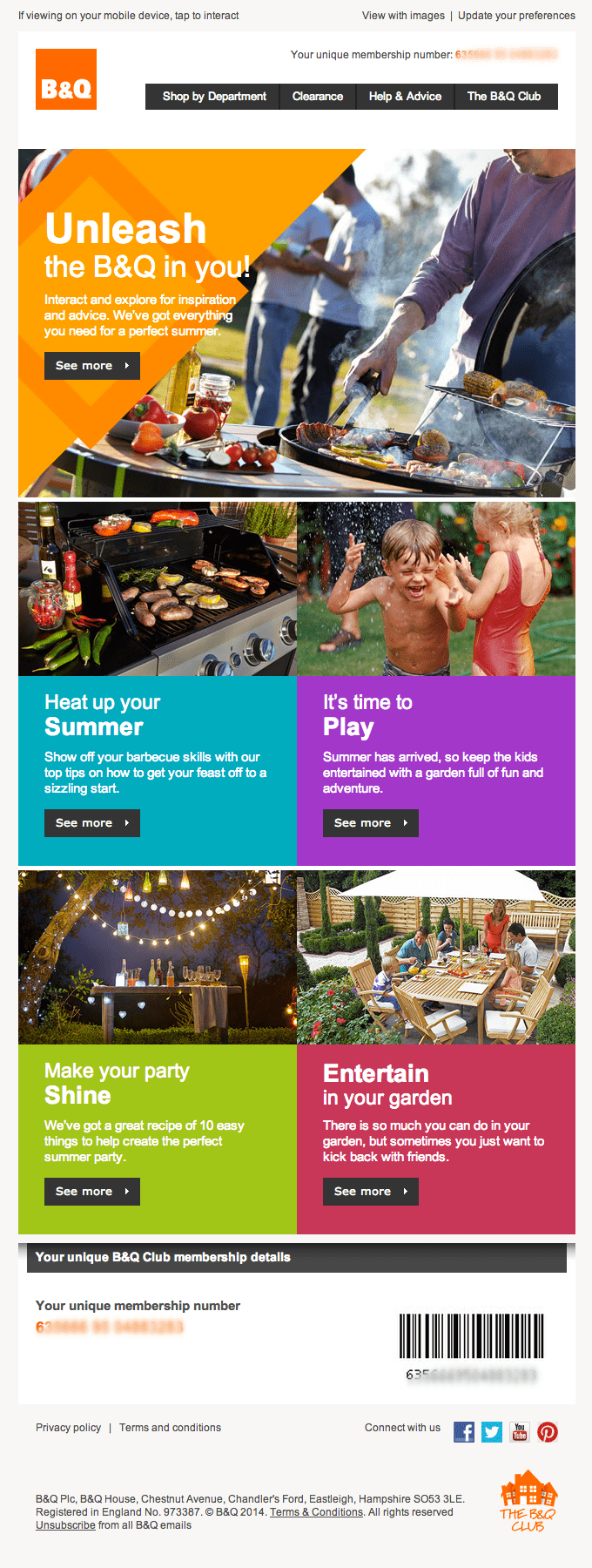
The Promotional Emails (Evaluation) - With your subscriber on the hook, you can seal the deal with some timely promotions. Promotional emails should be keyed to subscriber activity and interests as much as is possible.
The Seasonal Emails (Evaluation) - A good seasonal promotion can sometimes be just the thing to convert prospects into customers.
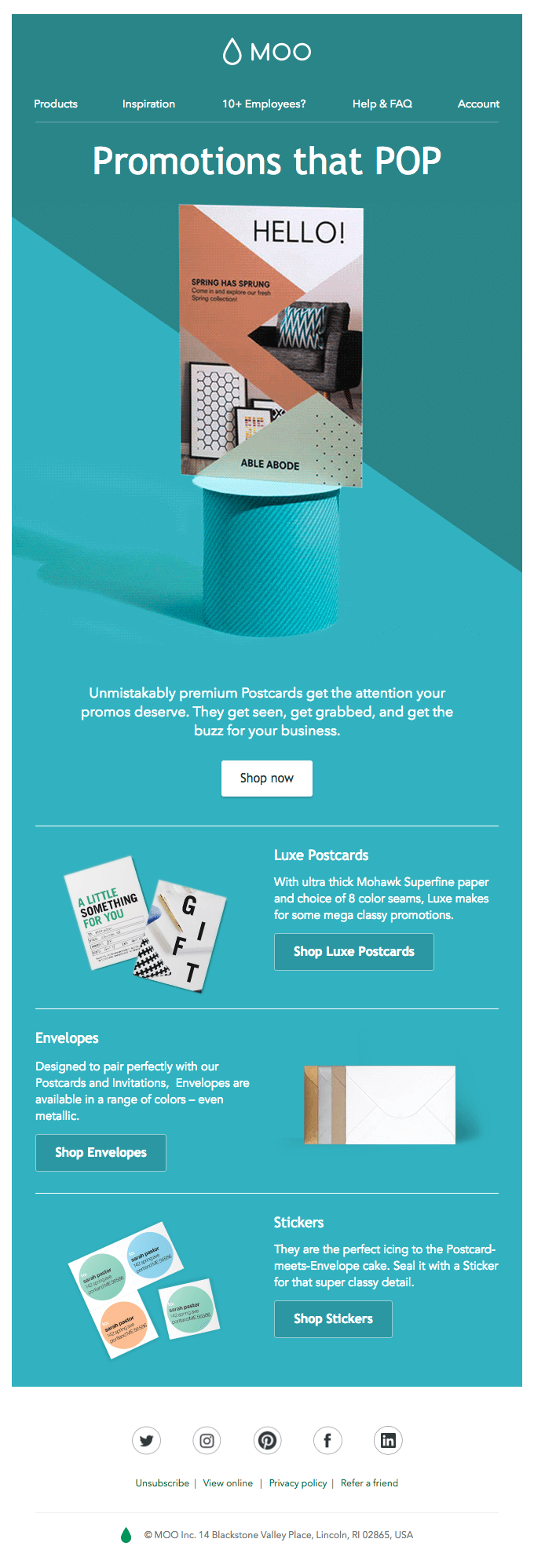

The Post-Purchase Emails (Purchase / Product experience / Bonding) - These emails should thank the customer for their purchase and be solicitous of their experience. Ask them about their experience with your product and encourage them to get in touch if they are having any issues.
The Triggered Email Series (Purchase) - Behaviors should trigger certain kinds of email – cart abandonment emails, for example, or shipping notifications.
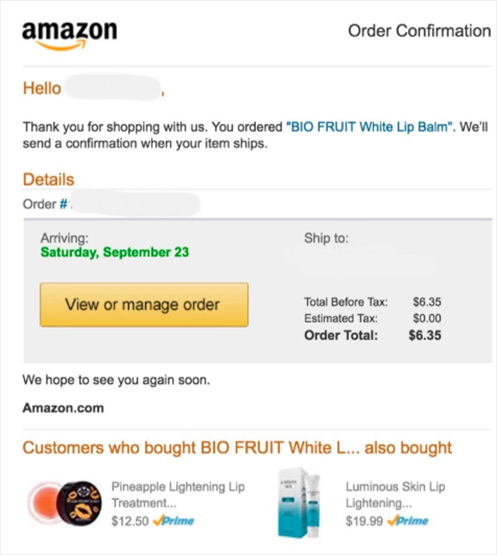

The Re-engagement Series (Evaluation) - Building a loyal brand/customer relationship is key here. Send promotions and content of interest to your customer, to deepen and strengthen your relationship.
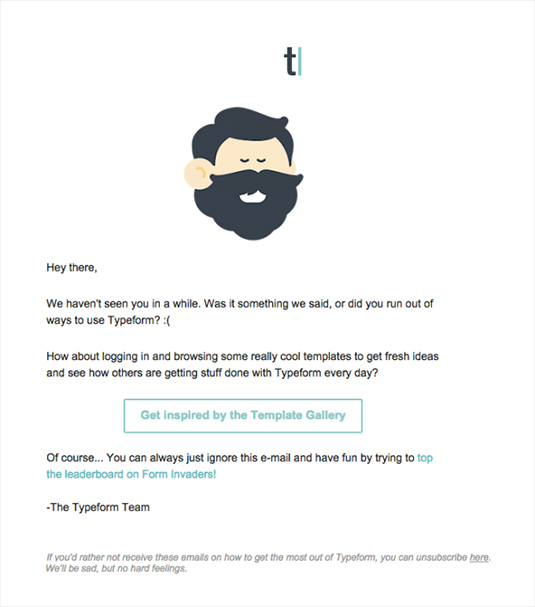
For those in the e-commerce industry, there are some additional email series you need to include in your set of emails:
Cart Abandonment Series. Coax your customer into coming back and going through the checkout.
Transactional emails Series (Order receipt, upsell, cross-sell, shipping notification)
In addition to the above emails, you have to include other emails which match the goal of your email campaign. Once you have decided on the kind of emails you will include in your email campaign, it is time to move forward to having those templates designed. We go into email customer journeys in more detail below.
Setting Up Email Automation
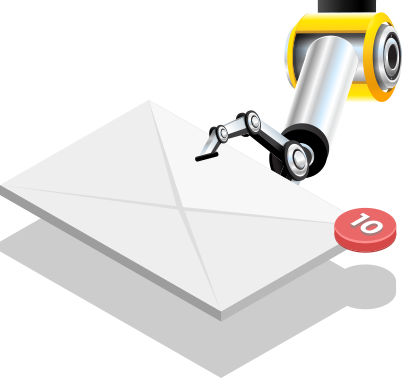
Now that you have all the email templates ready for dispersal, it is time to set up email automation. This will cut down the effort you need to expend considerably cut down, and ensure that your emails are timely, personalized and hyper-relevant to the reader. Email automations send specific emails to your subscribers when they satisfy the behavior trigger. These can be used for sending emails for repetitive tasks such as subscriber signup, post-purchase review, birthday / anniversary wishes, appointment reminders, etc. without user intervention.
Email automation series are a great way to nurture your leads, keep them updated with your brand & industry and schedule your email campaigns. Let’s see how email automation can help you to manage different email campaigns.
Lead Nurturing Series
According to research, 50% of leads generated by organizations are qualified, but not yet ready for purchase. So, it is important to ‘push’ such leads to the next stage of the sales funnel. However, you cannot afford to manage this manually, owing to short deadlines and limited resources.
Email automations can tap into your mailing list to identify leads and prospects who are currently on the fence about making a purchase. Such leads will automatically be sent nurturing emails (which you set) at regular intervals (decided by you) over a time course. Each email in the automation series needs to progressively introduce your brand as the solution to the problem they are facing or demonstrate the value of your services. A basic lead nurturing email automation series will have following emails:
-
The Problem email
This is the first email in the series and will focus on the problems or shortcomings of the current situation.
-
The Product Introduction email
This email will introduce the different products and services that your brand offers, while referencing how they will help the prospect to achieve their goals.
-
The Value Addition email
This email will demonstrate how your product will add value to your subscriber and guide them on how to use it.
-
The Transition email
This email will highlight how easy it will be for the subscriber to make the switch from their current choices to your products.
-
The Trust Building email
This email will feature a case study or testimonials from your existing customers to help build trust around your brand.
-
The Resources email
This email is more of an educational email featuring eBooks, blogs, templates, checklist, models, etc. for the subscriber to learn more about your product.
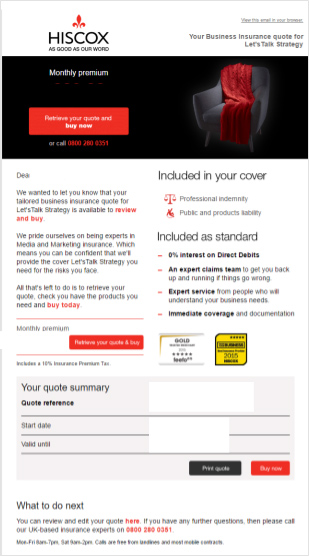
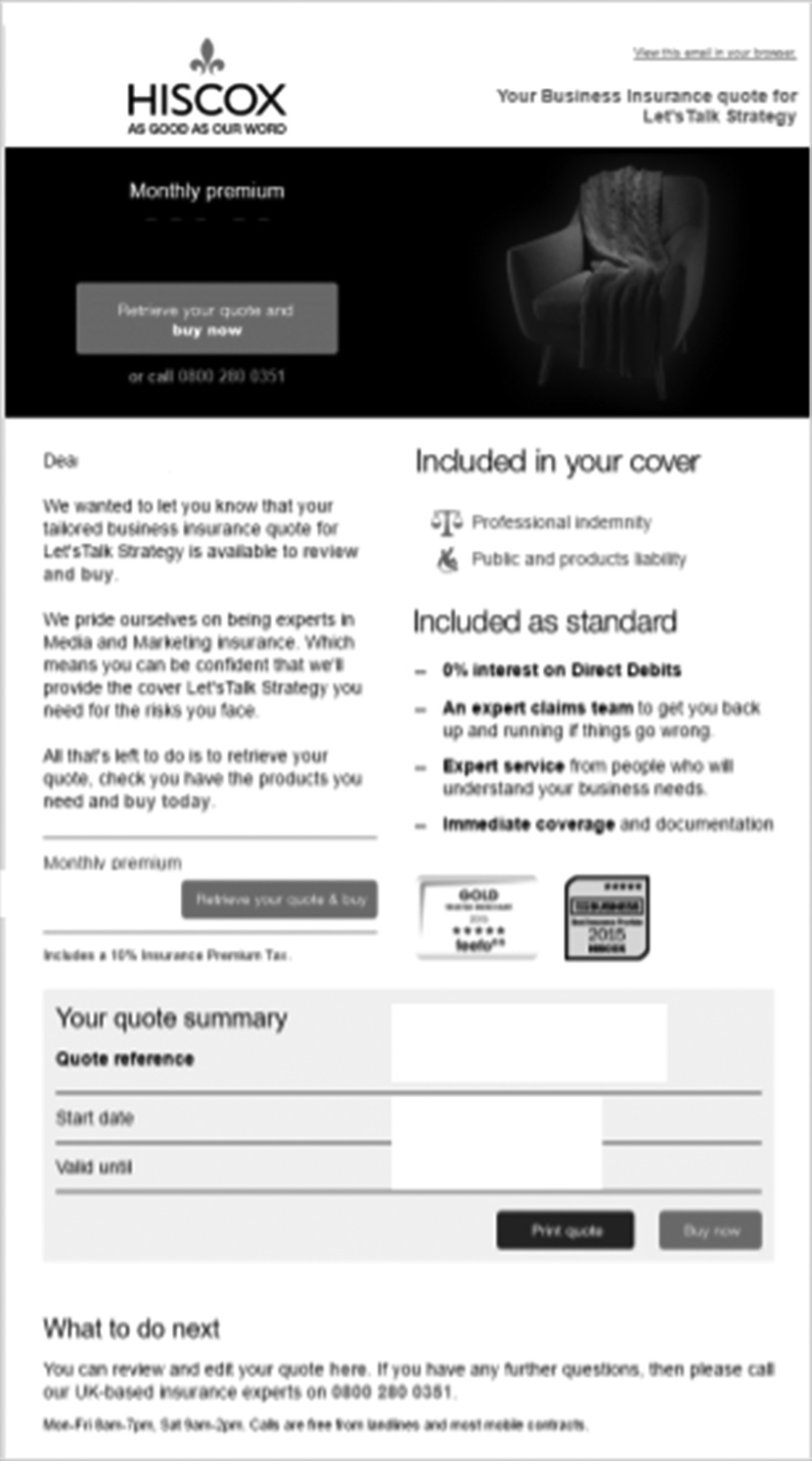

At the end of the series, it is assumed that your subscriber is capable enough to make a purchase. We suggest that you offer discounts to encourage them to make the jump.
Cart Abandonment Series
It is heartbreaking when a lead that you have painstakingly nurtured to make a purchase ends up abandoning the cart before the checkout. In fact, the global average cart abandonment rate is at 75.6% across all sectors.
Cart Abandonment Rates by Sector (Q1 2018)

Triggered cart abandonment emails come to the rescue by reminding the customer about the products waiting for them in the cart. Timing is crucial here as the chances of someone returning reduce as time passes. It has been observed that a reminder cart abandonment email sent within an hour of abandonment achieves maximum conversion. Email automation helps greatly in this situation as the emails will be triggered by the abandonment and the series will be periodically sent based on the user interaction. A simple cart abandonment email series contains the following emails.
-
The Reminder Email
This email should be sent within an hour of abandonment. The goal of this email would be to create urgency by showing limited stocks.
-
Cart Items Expiring Email
When you show the possibility of the products in the cart being unavailable after some duration, it creates the ‘fear of missing out’ effect in the subscriber’s minds. Send this email within 12 hours of abandonment.
-
You Just Missed It Email
After 24 hours, send an email that says that the subscriber has missed the opportunity. The goal of this email is to upsell or cross-sell relevant products with the hope of purchase.
Other trigger-based emails
Other email automation series that you can set up are transactional emails and re-engagement emails. Transactional emails are a series of emails sent to a customer on successful purchase such as order receipt, shipping details, order tracking emails, subscription renewal emails etc. They are not restricted to ecommerce since every industry has the end goal of customers making a purchase.
Earlier discussed in the list cleaning segment, re-engagement emails are another set of triggered emails, but the difference is that these emails are triggered when there is no user interaction for a long time.
Email Design Building Your Email
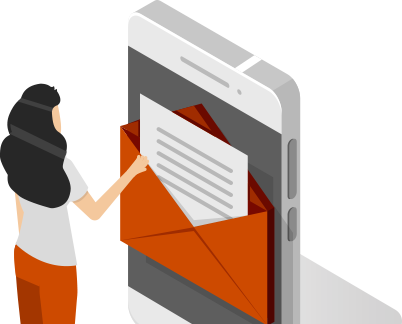
Pump the brakes! There is one more small step to take before tasking your email designer with designing the email template. You will need to keep your branding guidelines and brand assets ready for design. Our email development team at Uplers always refers the branding guidelines while designing an email for our 6500+ clients.
Brand assets are different design elements such as the logo, color schemes, fonts, copy tone etc. that define your business as a brand. A brand guideline is a document that instructs when and where the branding assets can be used. They help to maintain consistency across designs by demonstrating what a brand looks, feels and sounds like. Together, both create the brand identity that speaks about the mission, vision, audience, personality and values of the business.
Designing Your Email Template
Once you have the branding guidelines at your disposal, it is now time to design an email template. The first point on the agenda while designing an email template is the layout. An email layout dictates the placement and hierarchy of different elements of your email based on the eye scan path. Ideally, you should always design your email layout with a mobile-first approach - i.e. create a mobile layout first and then plan your desktop layout accordingly. This way, you are easily able to decide the re- arrangement of the elements in a responsive email.
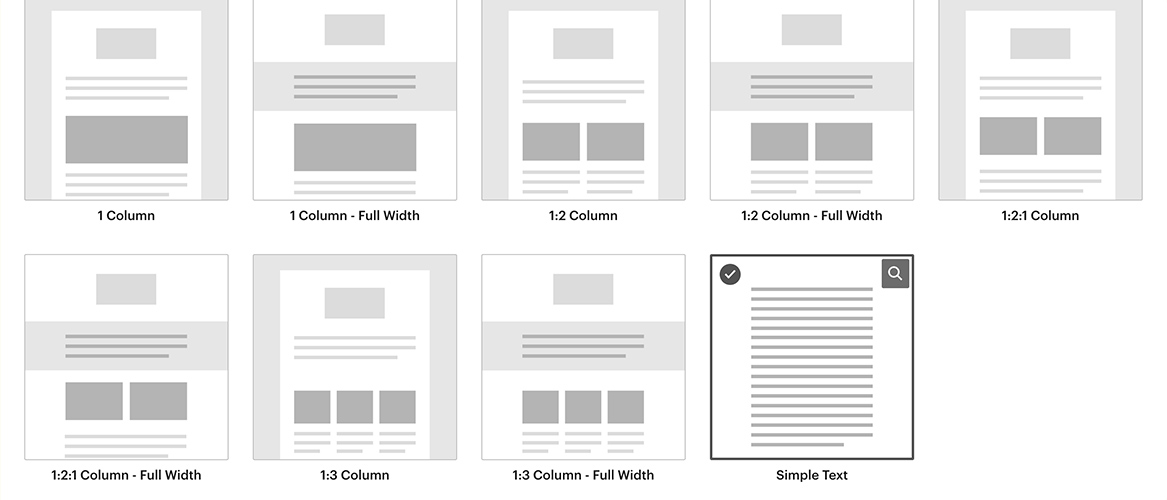
Once your email layout is decided, it is time to add relevant images with appropriate alt-txt, the email copy, CTA button, and relevant hyperlinks into the layout during email coding. Voila! Your email template is ready.
P.S: In real life, designing an email template is a complicated process which is best left to professional email designers. However, if you feel courageous, check out our Ultimate guide to email templates in order to understand how to create an email template.
Not sure how to design an email?
Get in touchEmail headers
The from name of the email is important to receive instant recognition from your customer. This should be
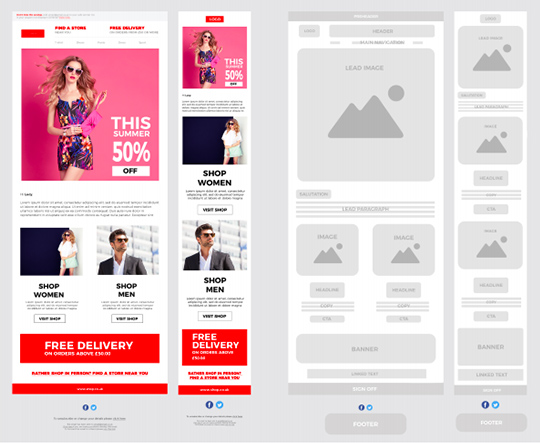
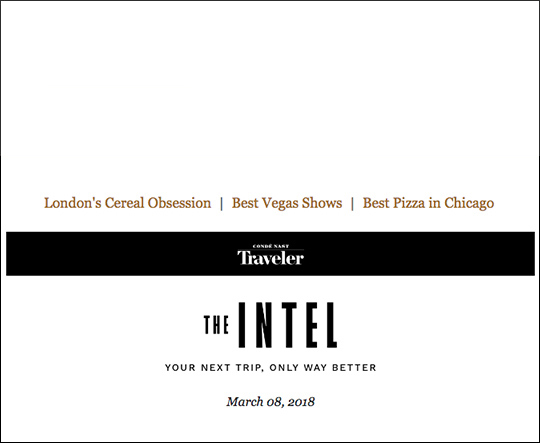
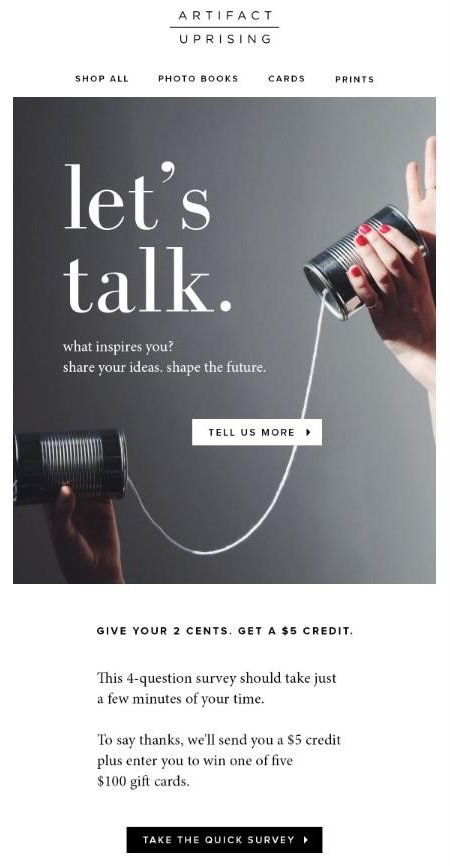
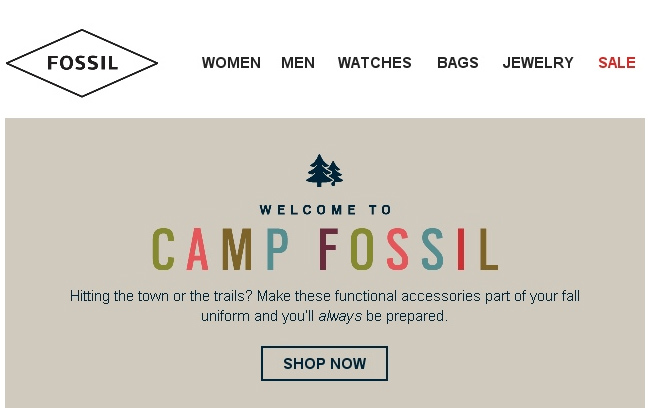
Building Your Email (Content)
While the email templates are being designed and coded, let’s move our attention to the next important part of an email template – email copy. Your email copy and design need to go hand-in- hand in order to effectively engage with your subscribers. Email copy motivates the subscriber to take action, while the design draws attention to the email copy. So, it is important to put as much emphasis on email copy as much as you do on email design.
The email copy can be categorized into three major parts:
-
Subject Line / Preheader Text
This is the first point of contact for your email to interact with your subscribers. Your subject line and pre-header text combo needs to hint at what the subscriber can expect to find inside just enough to raise their curiosity. 80% of email opens depend on your subject line.
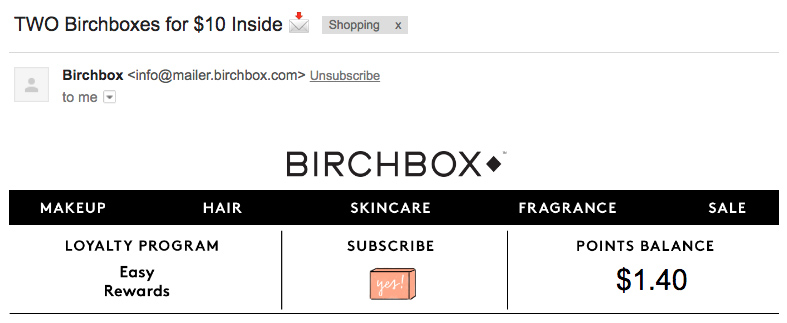
-
Introductory Copy
This is the content that would be displayed above the fold and have a strong link to the subject line to keep the readers interested. This is a key area for your email content, as it might be the only area your subscribers read, and it needs to engage them quickly to keep them reading.
-
Body Copy
The hook of the subject line needs to be answered here. This is main body of the email and the job of the body copy is to provide necessary information to guide the subscriber towards the final goal of your email campaign. The email copy needs to be created in such a way that your subscribers are tempted to click through your email and reach the dedicated landing page.
-
CTA
The CTA or the acid test of your email copy is testament to the effectiveness of your content. Yet, never consider the CTA button and the body copy to be two separate entities. The actionable CTA copy should be synergic to what was covered in the body copy in order to have your subscribers make the connection. Also consider the CTA from a reader’s point of view where they will be asking what’s in it for them, and what’s the value of clicking this CTA. If it isn’t clear what you want the reader to do, you’ll lose out on valuable actions being taken.
Your CTA can also be broken down into primary and secondary categories. The primary CTA will be the main one in the email content, the key button you want your readers to click. The secondary CTA is to complement and support the primary CTA.
Closing of the email – what’s the closing content of your email? What’s the key summary or the final message you want to share with your readers? This could be a personal sign off or a CTA reinforcing the action you want a subscriber to take.
Landing Page Creation
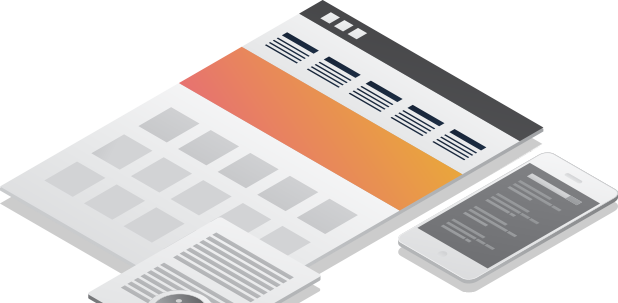
The real estate in the email is not enough to convey everything you need to say. So, your email needs to draw the attention enough for the subscriber to be directed to the landing page. A landing page needs to:
-
Display precise offer
to prospects -
Capture & convert
the leads successfully -
Collect prospects
data & information
So, it important that your landing page is consistent with your email. There are certain nuances you need to consider when it comes to landing page creation.
Anatomy of a Landing Page
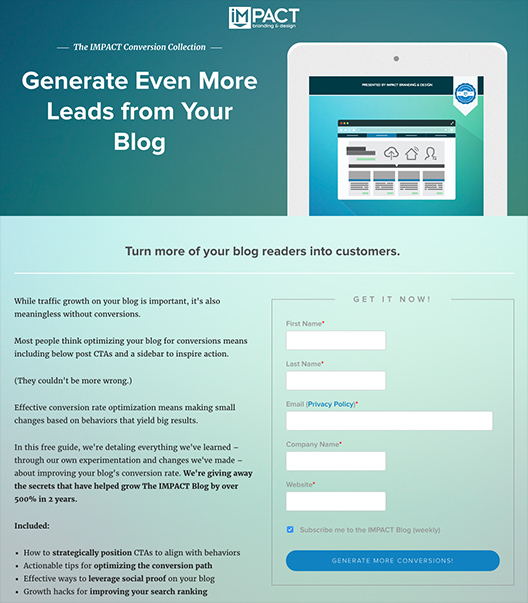
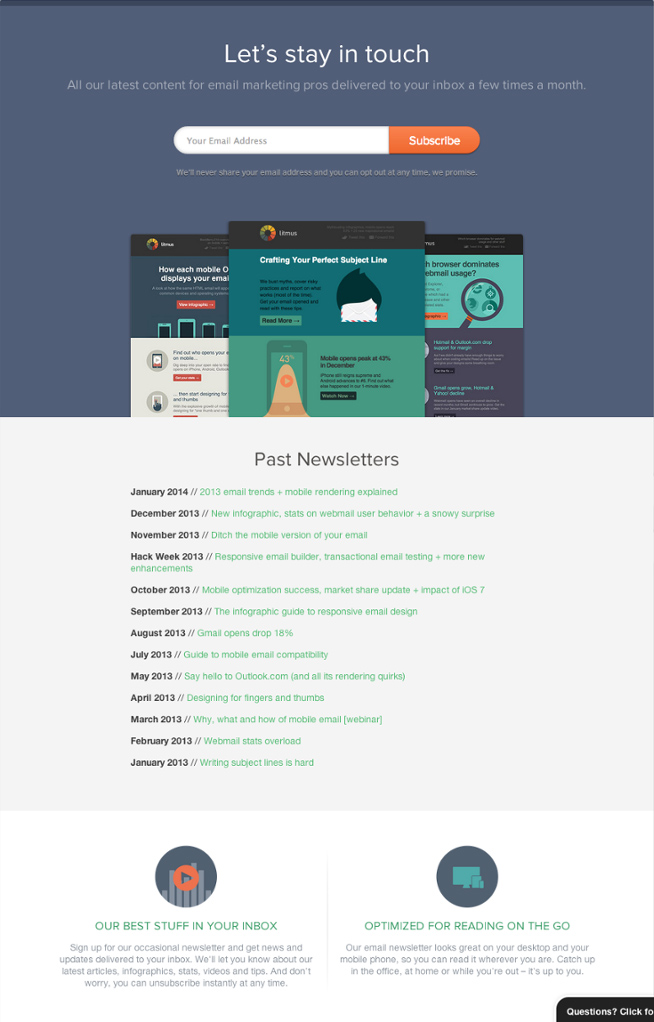
A landing page is a separate entity from your website and needs to have following elements to be considered a landing page.
- Attention Stealer Headline
- Captivating GIF/ Image slideshow
- Relatable Sub-Headline
- Call-to-action (CTA)
- Compelling Copy
- Testimonials/ Social Proofs
- Image/Video Supporting the Copy
- Lead Generating Opt-in Form
The elements are placed based on the visual hierarchy to guide the visitors’ eyes while they scan the content. According to the goal of your landing page, certain elements can be ignored.
E.g. if the goal is education, the lead capture form can be ignored, whereas if the goal is to generate leads, the form should be on the first fold along with an actionable call-to-action button.
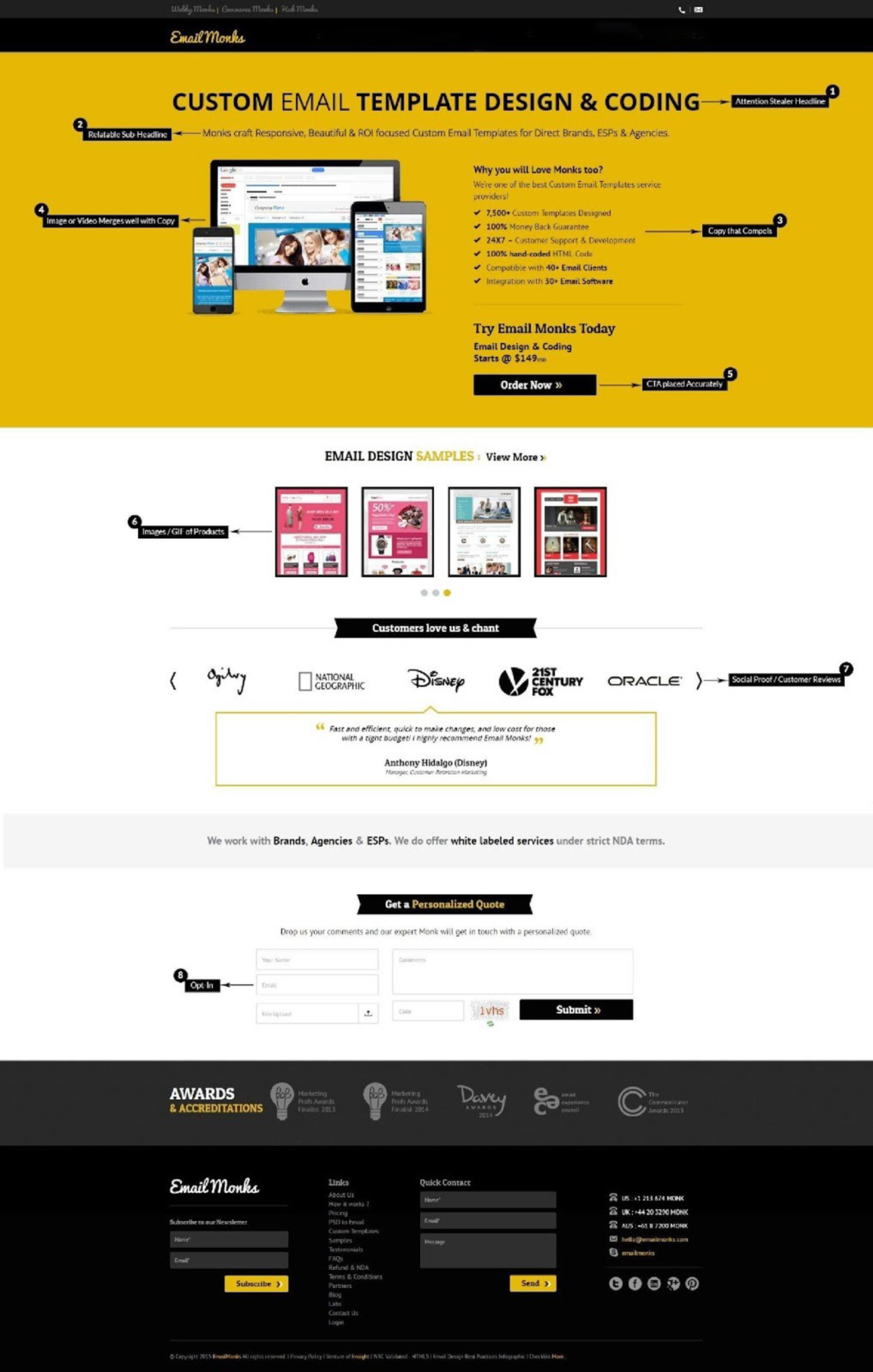
Goal of the landing page
The purpose of a landing page falls into two categories:
- To capture leads (Lead Capture landing page) such as this example:
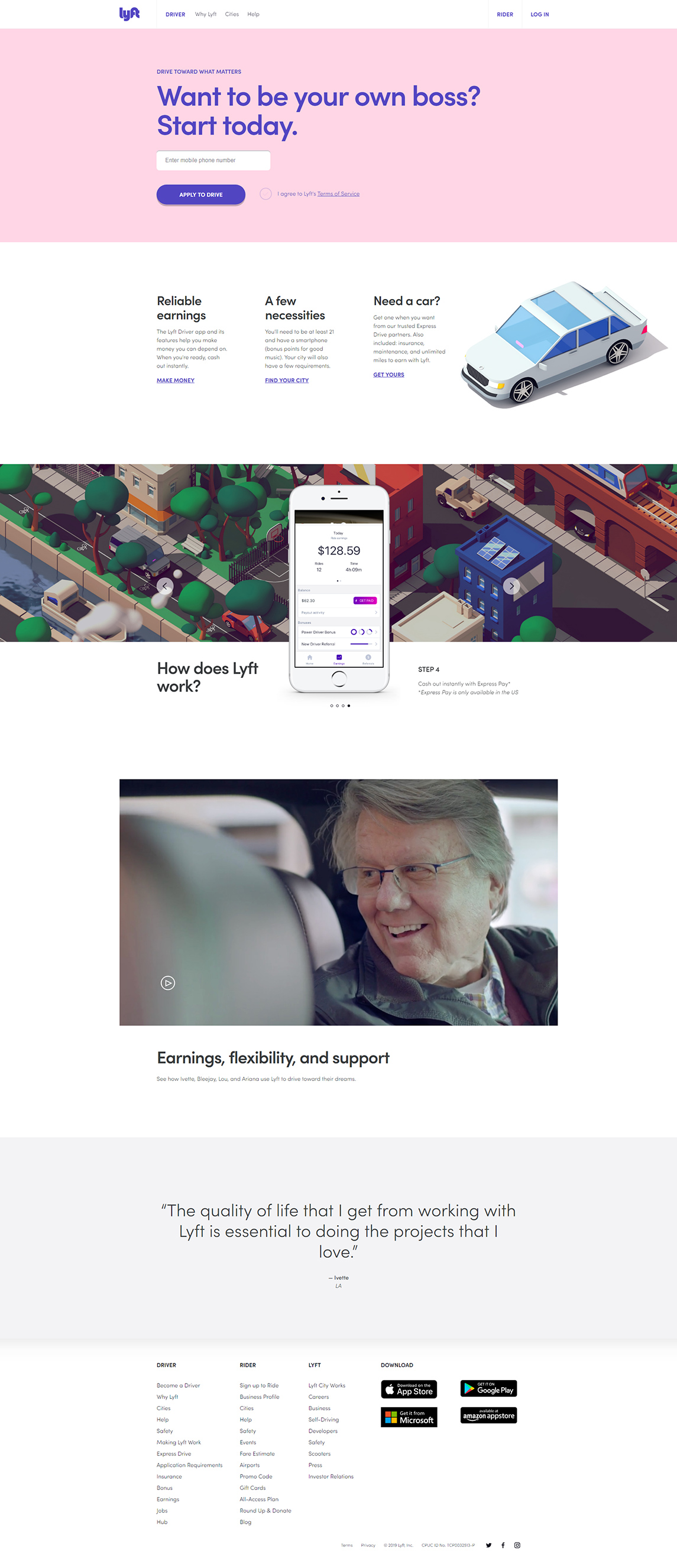
- To “educate and empower” the potential customers about a product before sending them further into your sales funnel. (Click through landing page)
Both landing page types have certain traits in common such as:
-
Clear Singular Objective
Any unnecessary navigation can result in your visitors getting bounced or directed to some other page. This will defeat the purpose of creating the landing page.
-
Separate landing page for each campaign
Whether you are collecting email address for a downloadable lead magnet or for email subscriptions, each landing page should be separate for each different campaign. This gives you enough subscriber segregation to target with different personalization.
-
Complete the conversation
Your email copy won’t be able to convey everything that you aimed while setting the goal. This is where the importance of the landing page needs to shine across. For lead generation pages, the conversation should highlight the advantages the subscribers get on subscribing. For click-through landing pages, the message should focus on explaining the action hinted in the email copy.
Looking for landing page services? Uplers can help you out.
Learn more
Best practices of landing page designs
- Your headline should reflect what you conveyed in your call-to-action. Preferably it should be a statement that hints at the problem area your visitor faces.
- An apt sub-headline would connect with the headline and reel the visitor further in to interacting with the page.
- Your copy should build trust on the visitors’ decision of landing on the page in the first place. Use bullets to highlight your USPs.
- Use images that are relevant to the message in the copy. Include appropriate alt-text to the images.
- Placement of CTA button depends on what your landing page offers. For lead generation i.e. while offering a freebie, CTA above the fold is more engaging. When trust-building through content is essential, the CTA should be after the content.
- Opt for progressive profiling to choose data fields in your lead capture page. This way you collect all relevant information and the subscriber does not feel overwhelmed.
- Responsiveness is the name of the game. Always build responsive landing pages.
- A/B testing is the most vital aspect to increase conversion.
A/B Testing Elements
While you may have a finger on the pulse of what the subscribers want, you cannot accurately predict what works for them and what doesn’t. At such crucial moments, testing two variants of same email element can help you to understand better. This is why A/B testing your email is important.
The concept behind A/B testing your email campaigns involves creating two identical email campaigns with only one email element different. The campaigns are sent to two different portions of your subscriber lists and the winning email is sent to the rest. The email elements that can be checked on A/B testing are:
- Subject Lines
- Email Copy
- Email Layout
- Images or Any Other Visual Element
- CTA Placement
- Email Length
Always conduct an A/B test based on a hypothesis instead of eyeballing the results. Also, the split should ideally be 15-15-70 or at least 25-25-50 in order to get accurate results.
Measuring email success
Tweaking Your Email Campaign Performances

It is time to test the effectiveness of your efforts. As we stated at the beginning of the article, the cumulative result of an email campaign when compared with the Key Performance Indicators reveals how effective the email campaign was in achieving its goals. Yet, measuring the campaign performance is not the end of an email campaign and every email campaign has scope for improvement.
Calculating ROI
One of the more obvious ways to assess a campaign is by calculating its ROI. The fastest way to do this is to compare the cost of the campaign against your send volume, your open rate, your clickthrough rate, your conversion rate, and the average value of a conversion. It may all look bewildering at first (and this isn’t exactly a foolproof way of getting the ROI), but it should give you some idea of how worthwhile your efforts have been.
ROI is not the be all and end all, however. If you set your KPIs well at the start of your campaign, you should be able to see reasonably well how effectively you’ve been hitting your targets. Don’t forget to evaluate on an ongoing basis as your campaign proceeds – this will make the final evaluation much easier.
Conducting a Template Audit
Email templates are designed with the visual hierarchy and optimum transfer of information in mind. However, conducting an email template audit can help you analyze the email template from a 3rd person point-of-view and discover glitches which were missed earlier. While A/B testing also helps test the effectiveness of certain email elements, it can only test one element at a time. In case of a template audit, the template is checked against following elements:
- Layout
- Web Version
- Width
- Alt Text
- Fonts
- Length of Email Copy
- Recognition
- Interactive Elements and Animation
- Subject Line
- Call To Action
- Preheader
- Unsubscribe Link
Email template redesigning is a costly and time-consuming activity, so the template audit should only be conducted periodically.
Avail Complimentary Email Audit Service from Uplers.
Click HereHow to conduct a campaign audit
Once you have conducted a template audit, the next place to plug leaks is in your email campaign itself. An email marketing audit is an analysis of critical components that can impact a company's email marketing results.
A campaign audit is essential for ensuring not only the success of your current campaign, but for the success of future campaigns as well. Plugging these gaps at the start will save you a lot of time and data-digging when it comes to ongoing and final evaluation. It will also give you a good idea of where your team’s blind spots are, so you’ll know what to look out for in the future.
Under an email campaign audit, the following factors are audited:
-
Email list hygiene. Are all your addresses relevant and engaged?
-
Segmentation criteria. What are your criteria, and have you segmented your lists effectively?
-
Sender name and email address. What do your details look like in a prospect’s inbox?
-
Subject line and pre-header text effectiveness. Are you grabbing attention from the get-go?
-
Email copy. Is your content useful, engaging, and personalized?
-
Accessibility of email. Can your email be received and read by everyone, regardless of location or of visual ability?
-
Sending time. Are your emails going out at relevant times?
-
Sending frequency. Are you sending emails so often as to be spammy, or so rarely as to lose engagement?
-
Sender reputation. Has Google got you down as a reputable sender? Are you trustworthy?
-
Email deliverability. Are your emails getting where they need to go?
It is worth spending time conducting your audit. Go through the above list with a fine-toothed comb and really get into the detail of what you’ve done.
Discovering Optimum Sending Time
There is no fixed send time. While some might get maximum opens at 10AM Tuesday, others may get maximum clicks on 7PM Wednesday. The send times also varies from industry to industry. So, the perfect send time needs to be identified using trial and error. One way to identify probable send times is by A/B testing. Another way is to monitor your website analytics to identify maximum visits and sending in that time range. Provided you have the geographical location of your subscriber, you can segment your email campaigns accordingly. Most ESPs also employ machine learning to suggest better send times for email campaigns.
Wrapping Up
Congratulations! You have finally made it to the end of this article, and you hopefully find yourself a bit more knowledgeable about the field of email campaigns. Bookmark and refer every time you find yourself in a pickle and looking for answers. All our campaign managers are trained to effectively execute your email campaigns by following the above-mentioned methods.
Check out our campaign management services in case you are looking for dedicated resources.